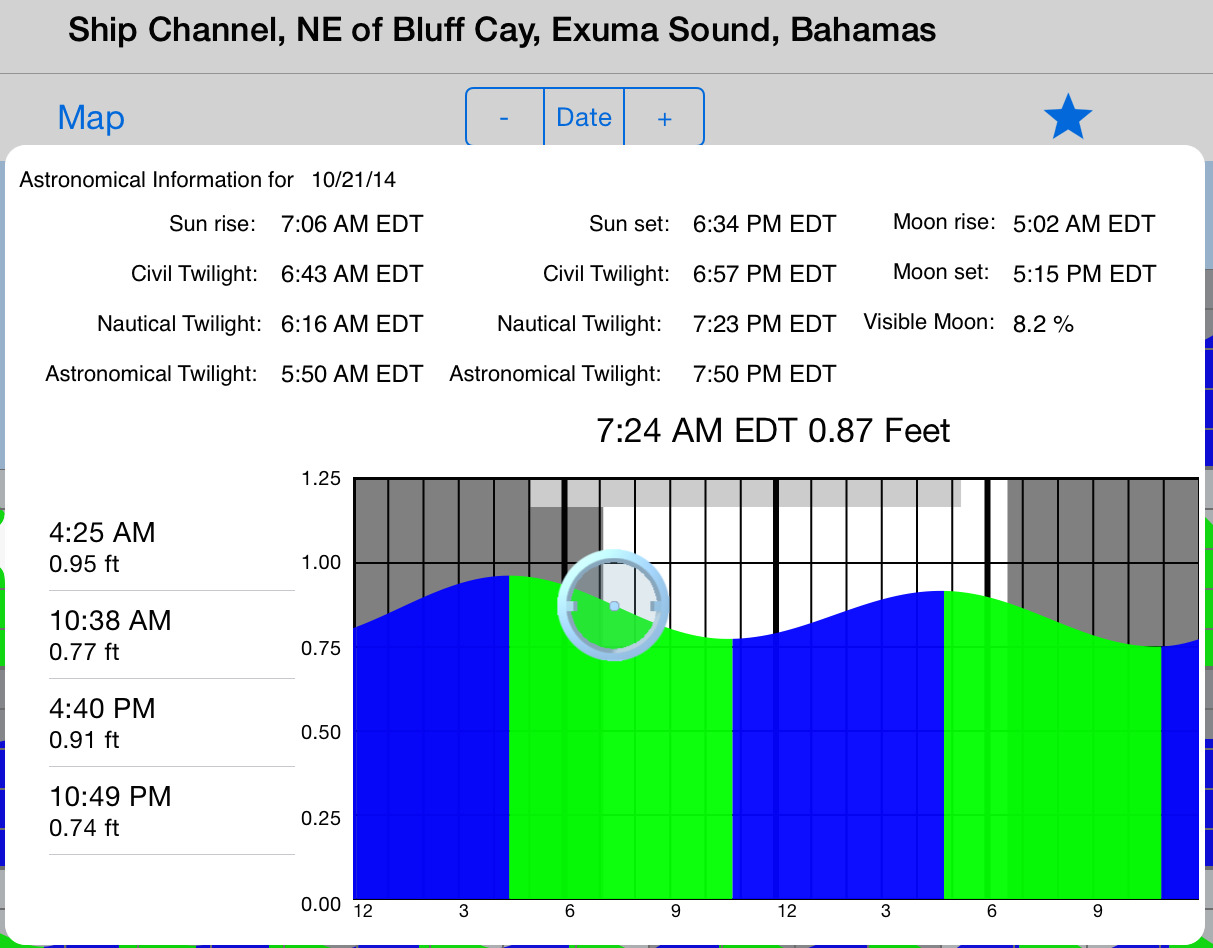Chloё McCardel - Exuma Sound

South Eleuthera Island to Nassau
77.3 miles
41 hours, 21 minutes on October 20-22, 2014
Observed and documented by David Barra and Brianne Yeates
World record, longest ocean swim
Swimmer
- Name: Chloё McCardel
- Age: 29 (b. May 10, 1985)
- Nationality: Australia
- Resides: Brighton East, Victoria, Australia
Swim
- Route: South Eleuthera Island to Nassau, Commonwealth of the Bahamas
- Body of Water: Exuma Sound, Bahamas, Atlantic Ocean
- Swim Distance: 124.4 km (77.3 miles)
- Distance Derivation: straight line between start and finish
- Start: October 20, 2014, 7:34am local (Eastern Daylight)
- Finish: October 22, 12:55am local
- Swim Duration: 41 hours, 21 minutes
- Historical Claims: World Record, Longest Nonstop Solo Unassisted Ocean Swim.
Route Details
Start: Lighthouse Beach, South Eleuthera Island. 24°36’56’‘N, 76°09’24’’ W.

Finish: Unnamed beach near outlet of Fox Hill Rd, south of Montagu Bay. Nassau City, Bahamas. 25°03’22’‘N, 77°17’17’’ W.
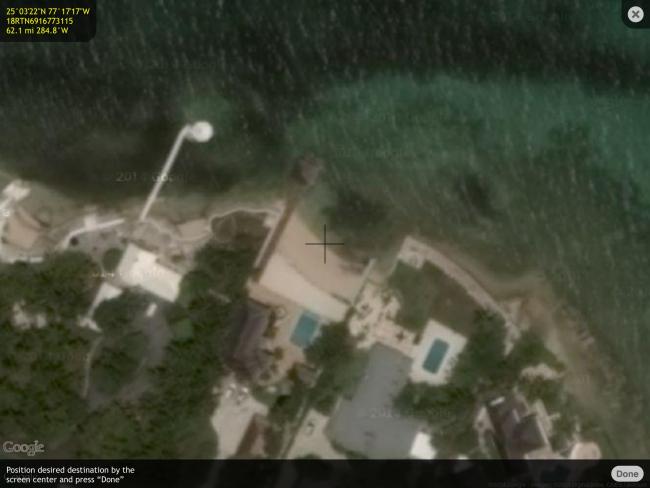
Support Personnel
- Pilots: Ron Knight, Malcolm Goodman
- Personal Crew / Feeding: Paul McQueeney, Ken Dixon
- Shark Safety: Andy Olday (lead), Mackey Violich, Candice Brittain, Alp Gökgöz, Beth McKenna
- Kayakers: Niles Furlong (lead), Patrick Lamontagne, Liz Shingsby, Patty Lee, Allison Baldwin, Jai Leal (EMT)
- Observers: David Barra (lead) and Brianne Yeates, representing the Marathon Swimmers Federation
Vessels
- Escort: 26’ panga – Kenny T
- Transport: 26’ panga – Mary Alice
- Mothership: 40’ Diving/Research – Cobia
- Port: Island School, Cow Point, Eleuthera
Rules and Conduct
- Swim Category: Unassisted marathon swim
- Swim Rules: MSF Standard, no deviations or exceptions
Equipment
- Standard: standard women’s speedo, Blue Tack earplugs, single latex swim cap, low profile goggles, lanolin / petroleum jelly grease mix.
- Additional: Electronic and chemical shark deterrents, shark spotters.
Summary of Weather and Conditions
- Air Temp: min 78F (25.6C), max 85F (29.4C)
- Sea Temp: 82F (27.8C)
- Winds: Force 0-2 (calm to 5-7 mph, with brief gust to 15 mph)
- Skies: Clear
GPS Track
Shown with route (white line).
Observer Narrative Report
Written by lead observer David Barra.
THE PLAN
Clare and I visited with Chloë and Paul in the summer of 2013. It was several weeks after Chloë’s Cuba to Key West attempt, they were already in the preliminary planning stages to find a location to make a distance record attempt. The Bahamas was high in the running and we started measuring point to point routes with a navionics app. With many options for start and finish points on both islands, the total distance could be adjusted rather easily, but the one constant seemed to be south Eleuthera to Nassau.
This route includes some extreme contrasts with roughly the first 42 miles through the Exuma Sound… a formidable deep canyon with steep walls dropping quickly to over 5000 feet. The perimeter marked with a strip of narrow cays after which the depth is less than 30 feet deep for the remainder. The clarity of the water is exceptional, which means during daylight hours you can easily see 80 feet or more. Most jellyfish are photophobic, and the shallows don’t provide enough respite from the sun’s exposure during daylight hours, so it is mainly the deep water and at night that presents the risk of jellyfish encounters. The ideal time to start this swim may have been a few hours earlier than the 7:34 splash time, but any tweaking would still require that Chloë spend pretty much a full night over the deepest water.
THE TEAM
The window for this swim was planned to start on Tuesday, October 21, 2014. I met up with Ken Dixon, a friend of Paul and Chloë’s who, along with Paul, would be handling the feeds and general crewing needs for this swim. Ken had traveled from Australia the night before, and spent only a couple of hours in the airport lounge at JFK to rest up for the next stage of the trip… A short 3 hour flight to Nassau where he would be meeting up with Andy Olday to spend the night and then fly to Rock Sound, Eleuthera in the morning with my second observer Brianne Yeates (see bio below)
I would board a Bahamas Air flight with Niles Furlong and head to Eleuthera directly from Nassau after a short layover.
During my stopover, I met up with Niles and checked my emails and the weather forecast. A Tuesday splash time looked okay, but the weather forecast seemed likely to change for the worse, which would affect the latter part of the swim. We were informed via email that the swim would be pushed up 36 hours, and we would shoot for a splash time of 7am Monday. Since we would have to be underway before the Bahamas Air morning flight arrived, we would start with half the crew, and rendezvous with the remaining team members several hours into the swim. This was the absolute right call to make as the forecasts were pretty dead on, and the wind and steady rain began Wednesday evening and continued to build to 30 knots by Saturday.
Sunday 10/19 evening: dinner at the Island School, and then a meeting with all members of the team present. The Island School and Cape Eleuthera Institute would be providing the majority of team members to this effort including boat pilots; Ron Knight and Malcolm Goodman, kayakers; Jai Leal (EMT), Patty Lee, Allison Baldwin, Liz Slingsby, Patrick Lamontagne, safety/shark divers; Candice Brittain, Makey Violich, Beth McKenna, Alp Gökgöz, … 12 persons total along for the journey in addition to Paul, Chloë, Brianne, Andy, Ken, Niles, film 7 crew Mike and Aaron, and myself.
Bio: Lead Observer David Barra
(Written by Evan Morrison)
David Barra is the co-founder and co-director of the 8 Bridges Hudson River Swim, an annual weeklong stage swim covering 120 miles between Catskill, New York and the Verazzano Narrows Bridge in New York City. He has completed numerous marathon swims, including the English Channel, Catalina Channel, Manhattan Island Marathon Swim, Tampa Bay Marathon Swim, Ederle Swim, Boston Light Swim, Cape Cod Bay, Maui Channel, In Search of Memphre, all seven stages of the 8 Bridges Hudson River Swim, as well as a 22-mile swim along the coast of Eleuthera.
Barra is an internationally-respected voice in the marathon swimming community. In 2012, the Marathon Swimmers Federation created the annual ‘Barra Award’ in honor of his prolific swimming, leadership, and volunteer work. In March 2014, Barra was profiled in a cover article in USMS SWIMMER magazine.
Bio: 2nd Observer Brianna Yeates
Brianne Yeates officially joined the Swift coaching staff in September 2014. Brianne has a degree in Exercise Science from the University of Tampa where she was a member of the Women’s Varsity Volleyball Team. She is presently working towards her ASCA Level 2 Swim Coach certification. Brianne runs the Fitness Group at St. Andrew’s school and assists with the Competitive I Group. She recently attended the FINA/BSF Open Water Swim Clinc where she received her Open Water Officials Certificate.
THE RULES
The MSF Rules of Marathon Swimming were read aloud. I was already keenly aware of Chloë’s commitment to the description of attire and conduct needed to classify a swim as UNASSISTED in the strictest sense, but several of the team were new to this concept, so the reading may have seemed like more of a formality but was likely the first introduction to this standard. I felt it was important that the entire team understand the details of these rules, and Chloë’s commitment to them.
THE ISLAND SCHOOL
My connection with the Island School dates back to 2006, where I was a coach for the first Total Immersion open water swim camp. I immediately fell in love with the location and the many easily accessible spots that offer a good variety of swimming opportunities. Since then, there have been lots of personnel changes, but the enthusiasm for aquatic activities is constant. Clare and I have visited regularly since then.
Vision
Leadership effecting change.
Mission
The Island School serves as a catalyst in the global transition to a more livable future through three institutional keystones:
- Developing an intimate sense of place in students through immersion experiences in the natural and cultural environment
- Modeling sustainability of individual lifestyles, larger communities, and the systems that support them
- Creating an intentional community whose members are cognizant of their abilities, limitations, and effect on others.
Central Question
How can we live better in a place?
THE CAPE ELEUTHERA INSTITUTE
THE PROVISIONS
Preparations and provisioning for the two days on the water now accelerated took on a frantic pace. Karen Knight put together menus for snacks and meals for the team of 20, the boats were fueled up, the meet up time for Monday morning was set for 5:30 AM at the Island School boat dock. We would load up the Kenny T, and the Mary Alice (both 26 foot Pangas. Center console, inboard diesel) which would get us to the start. Mary Alice returned to the Island School after deploying the first kayak team. Kenny T was in for the long haul and would be Chloe’s main support boat for the duration. The second support vessel, the Cobia is a 40 foot converted fishing trawler with a Michael Fitz hull design that the Island School and Cape Eleuthera Institute use as a dive boat and research vessel. The Cobia would wait for the remainder of the team to arrive and assemble and then meet up with us underway…. Some hours later.
THE START
Chloë entered the water and swam into the sandy beach in a shallow bay about 1k west of Lighthouse Point on Eleuthera, and started swimming at 7:34AM…. Heading: 295 degrees. Ron Knight at the wheel, Niles and Patrick kayaking. No noticeable wind; Air temp 79F / Water 82F…. The water would remain this temperature for the duration of the swim.
8:06 AM: At Chloë’s request, the Kenny T changed position to reduce exhaust fume exposure. For the duration of the swim, Chloë would swim in a position between her kayakers while the Kenny T would provide tracking and directional instruction from +/- 20 meters away. With no visual references available, the team relied on GPS and compass headings to maintain direction.
THE DATA
In addition to the Swim Log forms that I downloaded and printed from the MSF site, Brianne and I also used a small notebook as a redundant, just in case, extra copy of all the data. Additionally, I was running 2 separate GPS tracking programs on my ipad…. They are Navionics HD and Commander Compass. We took screenshots every 30 minutes, so before submitting the log to the MSF, I triple checked all the data with these programs and the two written lists. One issue I had to make adjustments for was the navionics app displaying a time one hour different, which I’m guessing has to do with daylight savings time. I wear a digital watch, and we also had a Timex stopwatch keeping running time.
There was a Spot Tracking devise on board the Kenny T. I had a backup unit as well that I never turned on. I should have. The boat was crowded at times, and it appears that for a brief period something was placed over the devise and transmission was interrupted. The unit continues to record, even when transmission is blocked. MSF has all the recorded data.
THE DEEP
The south coast of Eleuthera is surrounded by a narrow band of shallow water. The bottom is a mottled combination of sand, coral and sea grass and the water appears Pantone 325 (just because “aquamarine” is so 1970) in the morning sun. At about 2 miles the bottom drops out, and soon the depth is measured in thousands of feet. This would be the norm for the next 40 odd miles. The transition is abrupt and dramatic, and the swimmer’s view is that of deep infinite blue until the sun gets low, then it transitions to black.
THE DARK
Chloë was illuminated with a single round green light clipped on to her suit in the middle of her back. It was set on steady (as opposed to blinking) and the kayaks had green and red lights. The boats were also lit with green and red lights, to keep the glare down, and to reduce the odds of attracting sealife. The bioluminescence was abundant. We could see it everywhere there was disturbance in the water from the boats wake, to the kayaker’s paddle strikes to the flippers of the skin divers.
THE STINGERS
The crew members from the Cape Eleuthera Institute predicted that there was a good chance we would meet up with some of these SEA WASPS… technically a box jellyfish, but not the most toxic kind. I’ve read a little bit about these creatures, and they are actually hunters. Perhaps, the bioluminescent critters we were agitating was attracting them? I’m posting a link, though I am not certain that this is the exact variety of jellyfish Chloë was hit with more than a dozen times…. Still there is some pretty interesting information on this page.
THE SHARK/SAFETY PLAN
At each feeding, safety/shark divers were deployed to do a visual scan of the area. The clarity of the water is indeed exceptional and the divers are all very experienced working around the many varieties of sharks known to populate these waters. This includes tiger sharks, lemon sharks, reef sharks, bull sharks, hammer head sharks, oceanic white tips, etc. The Cape Eleuthera Institute has several ongoing research programs that study sharks in the Bahamas.
A sighting of any of these varieties of shark would be cause go into a higher alert mode, and deploy the shark/safety divers for as long as they are present to monitor their behavior. There were neither bang sticks nor spear guns nor any other weaponry on board.
Typical progression from sighting to encounter to a potentially dangerous situation as I understand it would be something like this:
- A curious swim by… Just to have a look.
- Closer passes.
- Bump… To identify object
- Taste
Up to 30 minutes could pass during such a progression.
I’m not sure at what stage of such a hypothetical encounter the swim would be called, but since there were zero sightings, it may very well be that the question is moot.
Andy Olday came equipped with shark shield electronic deterrent devices and semio chemical shark repellent. The former were attached to the 2 kayaks, and were rotated every couple of hours with additional units that were charging aboard the Cobia. The latter (a nauseating waxy compound made to simulate the essence of rotting reef shark corpse) was deployed from the Kenny T… Stuffed into a long nylon mesh bag and weighted to keep the scent deep enough Chloë so as not to sicken her. Though it is impossible to say whether these deterrents were effective in keeping sharks away, I can say with authority that none were spotted for the duration of the swim except for 2 nurse sharks. A blue marlin was spotted by Chloë and a trio of dolphins were seen in the distance some hours after we arrived in the shallows between Nassau and the Exumas.
Following is Andy’s description of the equipment and method of deployment used for this swim. Lots of links….check ‘em out:
Shark Encounter Prevention Protocols & Equipment Used For Chloë McCardel Swim: Bahamas, Oct 2014
Shark Shield
Throughout the entire duration of the swim one Freedom 7 Model Shark Shield was attached to the stern of each of the two escort kayaks. The shields were rotated with fully charged units approximately every 4 hours.
Semio Chemical Shark Repellent
SharkDefense.com Developed by Dr. Patrick Rice and Chemist Eric Stroud from Florida Keys Community College, Florida.
Beginning at dusk on the evenings of night one and two of the swim a single 8oz time released dissolving semio-chemical shark repellent bar was submerged and trailed behind the lead boat. The bar was replaced every 4-5 hours as needed until morning.
Neither the Shark Shield technology nor the semiochemical repellent have any long lasting negative effects on marine life.
Shark Repellent Aerosol
On hand durning the swim. Not deployed during the swim.
Safety Divers
Periodically throughout the duration of the swim, safety divers entered the water from the lead vessel to observe any marine life activity that may be within visual distance / perimeter / immediate vicinity of the swimmer. These in-water observations were conducted during every feed.
Prepared by Andy Olday Safety Office for Chloë McCardel 2014
Andy Olday Master SCUBA Diver Trainer Divers Direct - Key West (305) 293-5122 Mobile - (305) 509-0852 www.facebook.com/diversdirectkeywest
THE EXUMAS
Exuma is a district of the Bahamas, consisting of over 360 islands, also called cays. It was still night when we approached the Exumas… a bunch of little islands that divide the shallows from the Exuma Sound on west side of the canyon. With just a sliver of a moon, it was a very dark night, and so few navigational lights around. I expected to see a beacon on Beacon Cay. Our heading was dead on to pass just south between it and an unnamed rock. The course was accurate, but still, all eyes were looking forward as the cays were merely dark shadows on either side of the boat.
We were in the shallows now, and would be for the rest of the swim.
THE SHIFTS
I told Brianne that I wanted to see this through the night, and I would try to get a little rest after sunrise. She went to the mothership, Cobia, to grab a couple of hours sleep, so that we would switch out at daybreak. It was after we passed the Exuma Cays, and the sun had risen when I transferred to the Cobia for my first and only break. I was pretty tired, but I found myself unable to sleep for more than a few minutes at a time. Still, it felt good to stretch out on the COBIA for a couple of hours, and to my delight, housekeeping had seen to the Kenny T in my absence. In summary, both observers were aboard the Kenny T for the entirety of the swim except for the first few hours (we started the swim without the Cobia) and the hours between 12am and 7am on October 21 where Brianne and I took alternating respite on the Cobia.
THE SHALLOWS
Nassau is surrounded on its south and east by a vast area of shallow water… mostly under 20’ deep and peppered with small coral heads which show up as these little red “x” marks on the Navionics charts. While they would be hazardous to larger vessels, our fleet has a very shallow draft, so we were pretty much able to ignore the dark spots and continue to track straight. With a clear view of the bottom, Chloë stopped at one point and said there were many turtle shells on the bottom. Turtles are protected, but poaching is common. It was indeed a buzzkill for the entire team to know that we had come upon a dumping ground. The coordinates were recorded and hopefully reported to an authority that can enforce the restrictions on this practice.
THE CALORIES
Chloë’s primary source of calories was a combination of sport gels both regular and ccasionally caffeinated mixed with water and periodically coconut cream or coconut oil at a rate of every 30 minutes. Gastrolyte electrolyte products were also part of the rotation.
My best guesstimate would be that Chloë’s average caloric intake was between 250 and 325 calories per hour. Fluid intake averaged between 350ml and 500ml per hour. This seemed kind of low to me as my own average fluid intake in warm water is 900ml too 1200ml, but this didn’t seem to have a negative effect as Chloë was able to urinate regularly and without difficulty.
Additional items consumed without regularity were banana, ramen noodles, coffee, black tea, chocolate instant breakfast drink, bread with Nutella.
Feedings were accomplished casually and without urgency and on average would take between 30 and 60 seconds…. Some took a bit longer as when solid food was requested or when the application of additional grease was required. The latter was performed by Chloë by putting her hand in a small plastic bag and then grabbing a generous handful of goop from a sauce pan that was extended to her. Chloë reapplied grease to her armpits twice during the swim. Feeding was handled from the boat, from her kayakers and from a diver as conditions allowed.
THE PAIN
Many swimmers consume a steady flow of anti-inflammatory drugs during marathon swims. While on crew for an EC attempt with Kevin Murphy observing, we talked about the need to keep record of the swimmers intake and insure that they don’t exceed the recommended dosage. This is not something I considered before, but it made perfect sense to me, so Brianne and I recorded this information. See the log if you are interested in specifics.
THE LANDING
We were over 40 hours in, and a flood tide was starting. The decision was made to divert toward the shore line to try and minimize the effect of a head current and either continue closer to shore to the planned beach finish… or find a friendly landing spot before that. All 4 kayaks were now deployed. Two continued to flank and guide Chloë, and two went ahead to scout for a possible landing. A perfect sandy bottom little beach was found. There was a concrete dock/divider on the right where the Kenny T could pull up to. We moved ahead and did. The film crew, Paul, and I climbed off the boat and ran to the beach where Chloë was being directed to land. It was an emotional moment… Chloë cleared the water at 12:55am October 22, 2014. Check out the film footage if you haven’t seen it already. With little time to celebrate, Chloë quickly boarded Kenny T and was then transferred to the Cobia where EMT Jai and Patty began looking after her.
THE RECOVERY
We were all quite exhausted, and didn’t get to our rooms until around 3am. Chloë was admitted to the hospital, released, and then admitted again to keep a close watch on the injuries she sustained during the swim… Stings, blisters, burns… some had become infected and had to be drained. I had a long layover in Nassau on the 26th of October, and was able to visit Chloë at St. Margaret’s Hospital. It would be another couple of days until she was released.
THE RECORD
Full disclosure: I’ve been a Chloë McCardel fan since I met her in Dover September 2009. Having not yet crossed the English Channel once, she was attempting a double, and though it wasn’t in the cards that year, she returned to do it… and do it again. I never had any doubts that she could do this swim, and I’m honored to have been able to play a small role in its planning and thrilled to have been there to see it happen. I love swimming in the Bahamas, and I hope this swim will encourage others to test the waters there.
UNASSISTED 124.4k in 41hrs 21mins
Observer Log
Original Handwritten Report (6.3 MB PDF)
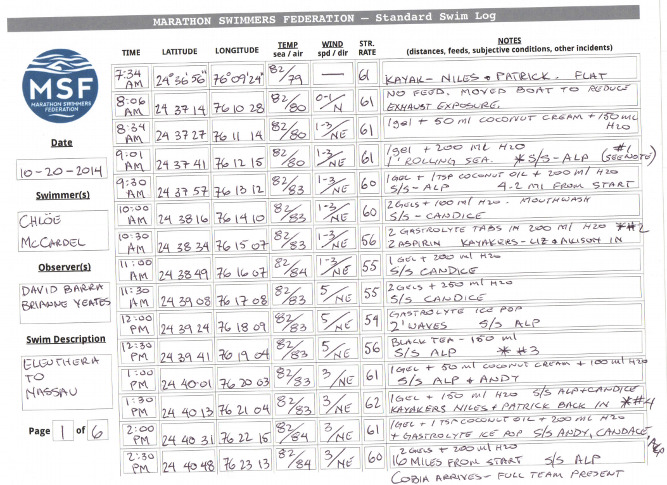
Typed Logs
October 20, 2014
(click to enlarge)
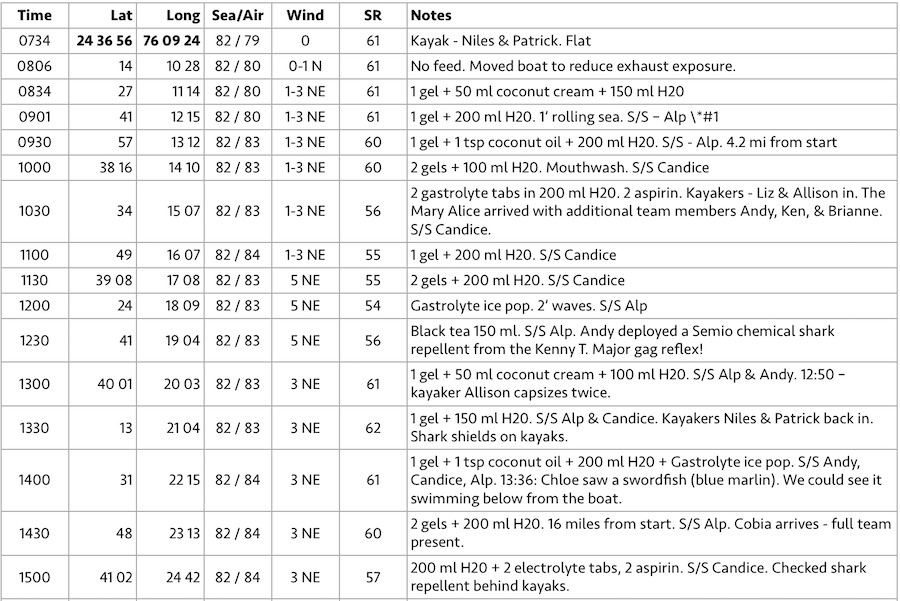
October 21 - 22, 2014
(click to enlarge)
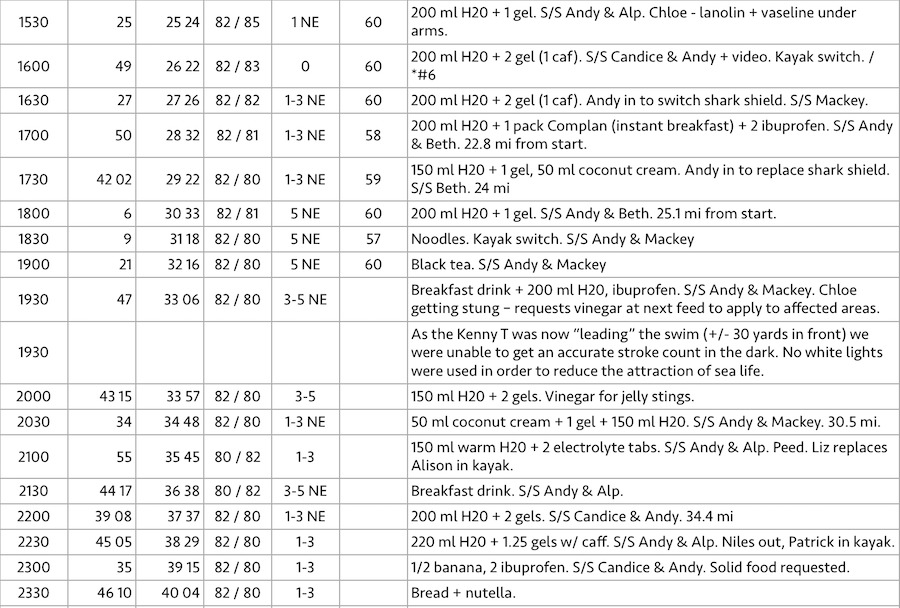
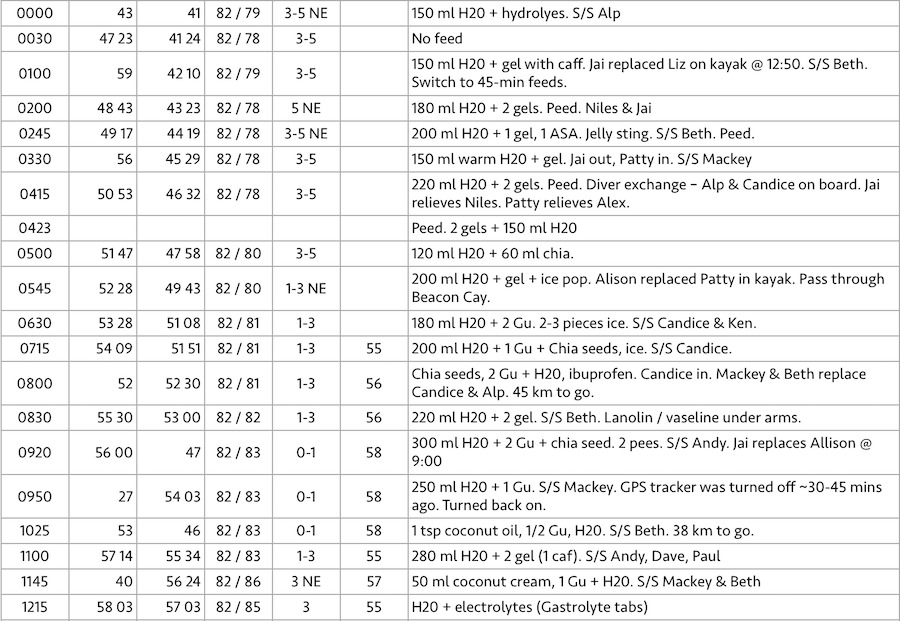
Tides and Currents
Statement from observer David Barra on the effect of local tides and surface currents on the swim:
The currents in the Exuma Sound were hardly noticeable. The differential between low and high tide during the swim on October 20-21 was 0.17ft. Low tide at 0.78 and high tide at 0.95 feet. Additionally, the light winds from the northeast offered neither help nor hindrance to the swimmer.
We met with a little head current at the end. Flood tides move from deep to shallow water, and narrow channels amplify the flow. This was a factor in deciding to land earlier than the planned finish since the flood was beginning and would continue for several hours.

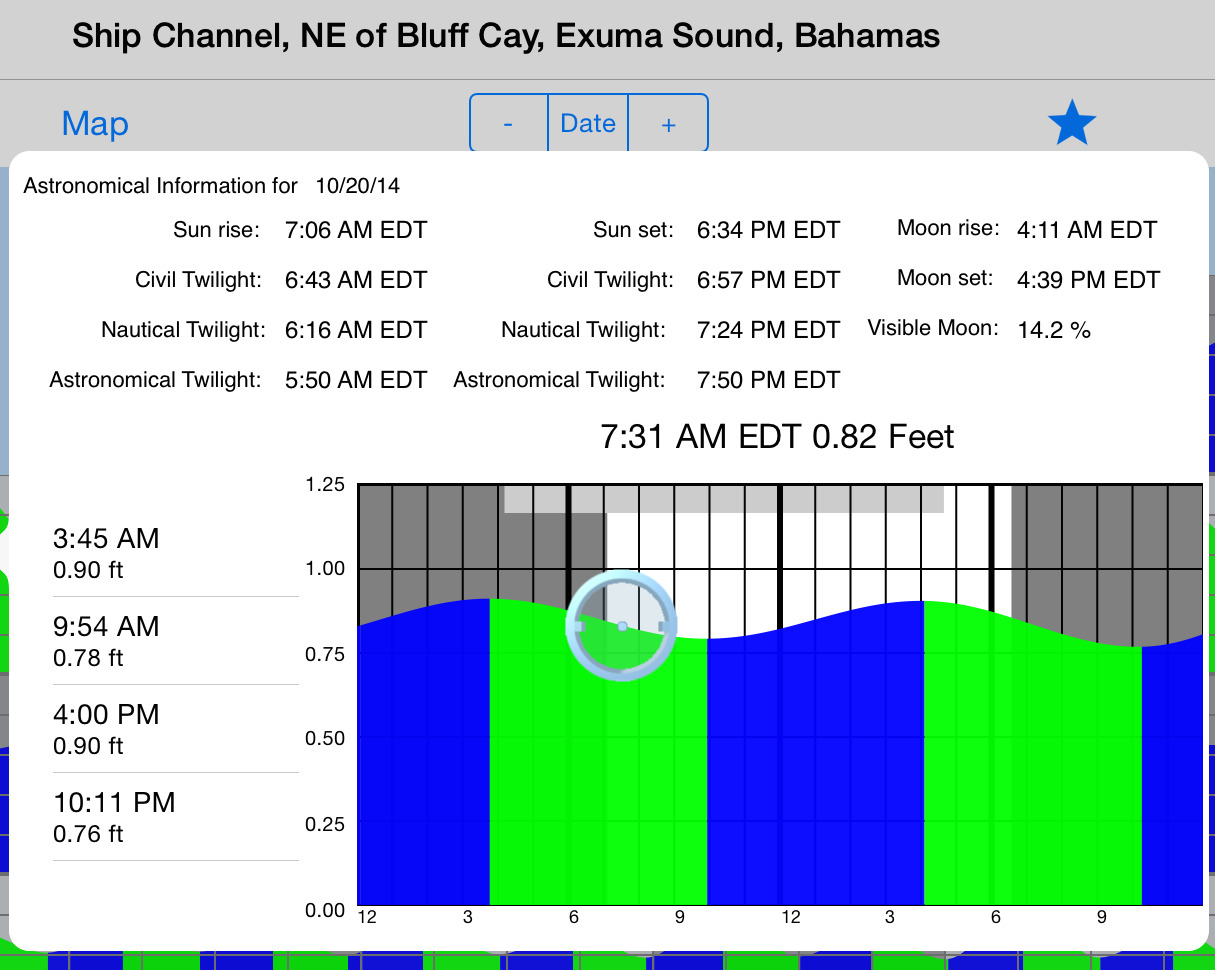
Swimmer Statement
Paul and I originally reached out to Donal and Evan in the months after the MSF was formed via email and mentioned that we felt there needed to be a standardised format for recognising swims such as ‘World Record’ distance attempts and ‘First Swims’ because there was no current organisation which effectively fitted this role and we also felt there was currently the opportunity for a small number of individuals to exploit marathon swimming by making fake swim claims for their own selfish means and to the detriment of the sport. We knew this would be a Herculean task to undertake but we also knew that Donal and Evan were quickly gaining the support and backing of a large cross-section of the marathon swimming community and if anyone were capable of doing this - they were! We had no idea they were thinking the same thing but we were very happy when they formed (along with a group of others) the MSF Rules and were very impressed by the thorough and definitive rules which were created not only for unassisted swims but also for assisted swims where there was no local swimming governing authority to recognise the swim.
Because Paul and I whole-heartedly believed in the MSF Rules it was only natural that we adopted them for my World Record Swim. As I was attempting my swim under the ‘unassisted’ category I was naturally exposing myself to whatever Mother Nature had in store for me. This has been a question frequently put to me – “Was it worth it?” (e.g. worth the sunburn and jellyfish stings to swim in the ‘unassisted’ category)? In fact, I was asked post-swim by an Indian journalist when considering the 15 jellyfish who stung me (it is assumed they are sea wasps –a type of Box Jelly Fish, but the actual species is not known) and extensive second degree burns “Would you do it again under the same rules?” and of course my answer was “Yes, I would do it again in a heart-beat because it was very important to me to achieve an unassisted World Record for this swim”.
The jelly-fish venom did drop my core temperature but, fortunately, due to the warm water, warm air temperature and warmed feeds my crew and I were able to manage this. Of course the stings were extremely painful, but I was able to manage this because of my high tolerance for pain and pain-killers. The biggest health issue was actually the sun burn – it was extensive and already creating welts/blisters during the swim which only got worse post swim. I believe if I had the same jelly fish stings and only minor sunburn I would only have required one day of hospitalisation rather than 5 days.
Commercially available sunscreen does not yet cater for the requirements of marathon swimming for swims beyond 4 – 8 hours. This is an area which improvements in sunscreen technology would easily make ultra-marathon swimming safer. I believe it is only a matter of time before a type of sunscreen or other product (potentially taken orally) is created which addresses this issue. Hopefully some entrepreneurial person can create an applicator to assist a swimmer to reapply sunscreen whilst immersed in the water and without touching the boat, or another person or being touched or makes a sunscreen which can last 24hrs+. I do not believe that stinger/body suits are necessary to complete ultra-marathons in tropical waters – I have proven that with my recent 124.4km World Record Swim in the Bahamas. If people argue that it would have been safer to wear a body suit which covered nearly my whole body for this swim than I would say “Yes, but just because it makes the swim safer doesn’t mean that it is necessary or the desired option”.
It would be much safer to wear wetsuits whilst swimming the English Channel as most swimmers will suffer a degree of hypothermia even to the point of causing a heart-attack. I myself have had dangerously low, life-threatening, core temperatures whilst swimming the English Channel during multiple crossing attempts, due to the cold water and air temperatures and from only wearing one pair of bathers as per English Channel rules. On one occasion I dropped into a semi-conscious state inhaling sea water which caused Pulmonary Edema and Pneumonia. I personally believe multiple English Channel crossing attempts under ‘unassisted’ rules are more ‘risky’ to one’s health than ‘unassisted’ tropical swims of the same distance.
Open water swimmers understand the risks before partaking in an event and if they wish to minimise these risks they can choose to enlist in an ‘assisted’ swim category and have it categorised accordingly or if they wish to be even safer they could just go and compete in pool swimming events! I don’t believe there is anything negative about completing an ‘assisted’ swim as long as you follow the rules for that category and you declare your rules in advance. People are not drawn to marathon swimming because it is easy and safe they are drawn to it as they have a strong desire to overcome difficult challenges both personally and against Mother Nature.
Paul and I are very proud to be associated with the MSF. Credibility, transparency and accountability are very important to us and we feel very lucky that my swim occurred after the creation of the MSF Rules as the MSF is an organisation which is highly reputable and at the forefront of international marathon swimming in the 21st century. We hope that my recent swim along with the other well documented MSF swims have raised the bar for swimmers in the future who wish to undertake World Record Attempts for Distance or First Swims as either ‘assisted’ or ‘unassisted’ swims undertaken where there is no local governing open water swimming authority.
As the MSF Rules become quickly and widely adopted we hope that swimmers and the media naturally ask this question where relevant “Why did a swimmer claim a record without going through the MSF or the local governing open water swimming authority?”. Hopefully the bar has been set and only time will tell how future record attempt swimmers will approach their swims - but I implore everyone for the betterment of our sport to promote, support and where applicable utilise the MSF Rules so that not only the swimming community but also the media and the general public become better educated as to the expectations and standards of our sport.
On another note, many thanks to David Barra and Brianne Yeates our official observers for generously giving their time and expertise, a HUGE THANKS to Paul and the entire support crew and land crew teams who invested so much energy and time to enable this swim to go ahead under MSF Rules. I would also like it to be noted that Paul and I specifically sort out a course which did not offer current assistance as this would have triggered my swim to be categorised in the ‘assisted’ category.
